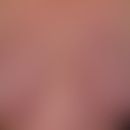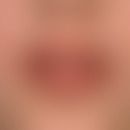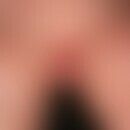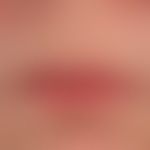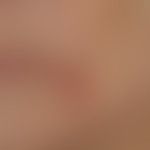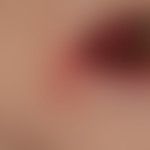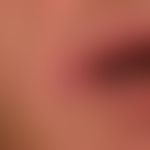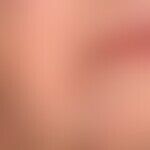Synonym(s)
DefinitionThis section has been translated automatically.
Polyetiological, acute or chronic, usually rhagadiform inflammation of the corners of the mouth. Often with mycotic or bacterial infection on the basis of an anatomical malposition.
EtiopathogenesisThis section has been translated automatically.
You might also be interested in
ClinicThis section has been translated automatically.
Initially circumscribed redness and scaling at the corner of the mouth, then rhagade formation. Formation of an oval, lentil- to pea-sized, erosive-crustose plaque. Particularly in older people, the finding may be completely hidden by the overhanging lips and only becomes visible when the corners of the mouth are pulled apart. The skin-on-skin situation at the corners of the mouth, combined with age-related hypersalivation and "salivary incontinence", causes a constantly moist environment of these skin areas with the risk of microbial colonization.
DiagnosisThis section has been translated automatically.
Characteristic clinical picture with painful rhagaden formation.
Eminently chronic course.
Resistance to therapy (if cause, e.g. anatomical malposition, is not eliminated).
Frequent age-related atrophy of the lips and cheeks with flat overlapping of the corners of the mouth.
Smear with examination for fungi and bacteria (not infrequently detection of yeast/candida species) Exclusion of diabetic metabolic condition.
Exclusion of anemia/iron deficiency.
Exclusion of avitaminosis (vitamin B12 deficiency), zinc deficiency.
Clarification of an atopic diathesis.
Clarification of immunosuppressive or antibiotic therapy.
Syphilisserology (plaques muqueuses = rare cause!).
TherapyThis section has been translated automatically.
Treatment of the underlying disease e.g.:
- Lip involution: In senile lip involution with overlapping wrinkling in the area of the corners of the mouth and age-related loss of turgor of the facial skin, consistent lip care with greasing ointments (e.g. lanolin-based); regular cleaning of the corners of the mouth (e.g. with dexpanthenol ointment).
- Candidiasis of the oral mucosa: Consistent antifungal therapy. See below antimycotics.
- Bacterial colonization: Apply antibiotic-containing ointments, e.g. Fucidine ointment, to the corners of the mouth several times a day. Alternatively: application of disinfecting ointments or emulsions such as 0.5% Clioquinol-Externa(e.g. Linola-Sept, R049).
- If the overlay is highly inflammatory, the application of combination preparations(glucocorticoid +antibiotic/antifungal) may be helpful in the short term (e.g. Decoderm tri cream, Candio-Hermal Plus paste, Lotricomb cream).
- Cave: Limit glucocorticoid combination preparations to 10-day duration of use.
- In atopic cheilitis, consistent lip care with greasy lipsticks or ointments.
TablesThis section has been translated automatically.
Causes of perlèche
Infections |
Candida species (so-called angulus infectiosus candidamyceticus, see also candidosis of the oral mucosa) |
Streptococci, staphylococci (e.g. in impetigo contagiosa), often mixed flora | |
In case of unilateral perlèche V.a. syphilis (see below Syphilis acquisita) | |
| |
Mechanical factors |
Unhindered salivation in the absence of oral closure (elderly) or in age-related dermatochalasis with the upper and lower lateral parts of the lips lying on top of each other. |
Hypersalivation (e.g. in mongolism) | |
Prognathism | |
| |
In the context of lip eczema |
As a manifestation of atopic eczema |
| |
Metabolic disorders |
diabetes mellitus |
Iron deficiency | |
Vitamin B12 deficiency (pernicious anemia) | |
Avitaminoses | |
Incoming links (19)
Angular cheilitis; Angulus infectiosus candidomyceticus; Angulus infectiosus oris; Ariboflavinosis; Atopy; Atopy; Cheilosis; Chronic mucocutaneous candidiasis; Corner of the mouthcheilitis; Corner of the mouth rhagades; ... Show allOutgoing links (10)
Antibiotics; Antimycotics; Atopic cheilitis; Atopic diathesis; Avitaminosis; Candidoses; Clioquinol; Clioquinol cream 0.5-2% (o/w); Glucocorticosteroids; Rhagade;Disclaimer
Please ask your physician for a reliable diagnosis. This website is only meant as a reference.


